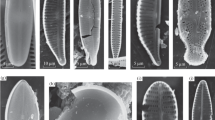Abstract
The content and distribution of amathamide alkaloids within single colonies of the bryozoanAmathia wilsoni (Ctenostomata) varied depending on the location in the colony. Three colonies in all, collected from the same site at the same time, were analyzed and gave very similar results. The outermost, more exposed, tips of the colony had an alkaloid content of nearly 9% of dry weight, while basal parts were apparently devoid of alkaloids. Samples taken midway between tips and base yielded intermediate concentrations of about 1%. Very little variation in the proportions of individual amathamides A, B, C, E occurred between exposed tips of the colonies. However, some differences in ratios were found between tips from exposed and more protected regions.
Similar content being viewed by others
References
Al-Ogily, S.M., andKnight-Jones, E.W. 1977. Antifouling role of antibiotics produced by marine algae and bryozoans.Nature 265:728–729.
Anthoni, U., Nielsen, P.H., Pereira, M., andChristophersen, C. 1990. Bryozoan secondary metabolites: A chemotaxonomical challenge.Comp. Biochem. Physiol. 96B:431–437.
Bakus, G.J., Targett, N.M., andSchulte, B. 1986. Chemical ecology of marine organisms: An overview.J. Chem. Ecol. 12:951–985.
Best, M.A., andThorpe, J.P. 1985. Autoradiographic study of feeding and the colonial transport of metabolites in the bryozoanMembranipora membranaeea.Mar. Biol. 84:295–300.
Blackman, A.J., andFu, S.-L. 1991. Aβ-phenylethylamine derived possible biosynthetic precursor to the amathamides, alkaloids from the bryozoanAmathia wilsoni.J. Nat. Prod. 52:436.
Blackman, A.J., andGreen, R.D. 1987. Further amathamide alkaloids from the bryozoanAmathia wilsoni.Aust. J. Chem. 40:1655–1662.
Blackman, A.J., andMathews, D.J. 1985. Amathamide alkaloids from the marine bryozoanAmathia wilsoni Kirkpatrick.Heterocycles 23:2829.
Carté, B., andFaulkner, D.J. 1983. Defensive metabolites from three nembrothid nudibranchs.J. Org. Chem. 48:2314–2318.
Christophersen, C. 1985. Secondary metabolites from marine bryozoans. A review.Acta. Chem. Scand. 39B:517–529.
Coll, J.C., andSammarco, P.W. 1988. The role of secondary metabolites in the chemical ecology of marine invertebrates. A meeting ground for biologists and chemists.Proc. 6th Int. Coral Reef Symp. Aust. 1:167–174.
Davis, A.R., andWright, A.E. 1990. Inhibition of larval settlement by natural products from the ascidian,Eudistoma olivaceum (Van Name).J. Chem. Ecol. 16:1349–1357.
Davis, A.R., Targett, N.M., McConnel, O.J., andYoung, C.M. 1989. Epibiosis of marine algae and benthic invertebrates: Natural products chemistry and other mechanisms inhibiting settlement and overgrowth, pp. 85–114,in P.J. Scheuer (ed.).Bioorganic Marine Chemistry, Vol. 3. Springer-Verlag, Berlin.
Dyrinda, P.E.J. 1983. Modular sessile invertebrates contain larvatoxic allelochemicals.Dev. Comp. Immunol. 7:621–624.
Faulkner, D.J. 1990. Marine natural products.Nat. Prod. Rep. 7:269–309.
Gerhart, D.J. 1986. Prostaglandin A2 in the Caribbean gorgonianPlexaura homomalla. Evidence against allelopathic and antifouling roles.Biochem. Syst. Ecol. 14:417–422.
Hay, M.E., Paul, V.J., Lewis, S.M., Gustafson, K., Tucker, J., andTindell, R.N. 1988. Can tropical seaweeds reduce herbivory growing at night? Diel patterns of growth, nitrogen content and chemical versus morphological defenses.Oecologia (Berlin) 75:233–265.
Norris, J.N., andFenical, W. 1982. Chemical defense in tropical marine algae.Smithson. Contrib. Mar. Sci. 12:417–431.
Rittschof, D., Hooper, I.R., Branscomb, E.S., andCostlow J.D., 1985. Inhibition of barnacle settlement and behaviour by natural products from whip corals,L. virgulata (Lamarck, 1815).J. Chem. Ecol. 11:551–563.
Sears, M.A., Gerhart, D.J., andRittschof, D., 1990. Antifouling agents from the marine spongeLissodendoryx isodictyalis Carter.J. Chem. Ecol. 16:131–168.
Sieburth, J., andConover, J.T. 1965.Sargassum tannin, an antibiotic which retards fouling.Nature 208:52–53.
Silen, L. 1977. Polymorphism in bryozoa, pp. 184–227,in R.M. Woollacott and R.L. Zimmer (eds.).Biology of Bryozoans. Academic Press, New York.
Steinburg, P.D. 1986. Chemical defenses and the susceptibility of tropical marine brown algae to herbivores.Oecologia (Berlin) 69:628–630.
Suffness, M., Newman, D.J., andSnader, K., 1989. Discovery and development of antineoplastic agents from natural sources, pp. 132–168,in P. Scheuer (ed.).Bioorganic Marine Chemistry, Vol. 3. Springer-Verlag, Berlin.
Sweeley, C.C., Elliott, W.H., Fries, I., andRyhlage, R. 1966. Mass spectrometric determination of unresolved components in gas chromatographic effluents.Anal. Chem. 38:1549.
Van Alstyne, K.L. 1988. Herbivore grazing increases polyphenolic defences in intertidal brown algaFucus distichus.Ecology 69:655–663.
Author information
Authors and Affiliations
Rights and permissions
About this article
Cite this article
Walls, J.T., Blackman, A.J. & Ritz, D.A. Distribution of amathamide alkaloids within single colonies of the bryozoanAmathia wilsoni . J Chem Ecol 17, 1871–1881 (1991). https://doi.org/10.1007/BF00993734
Received:
Accepted:
Issue Date:
DOI: https://doi.org/10.1007/BF00993734




